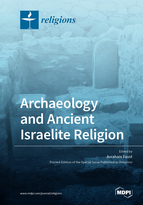Archaeology and Ancient Israelite Religion
A special issue of Religions (ISSN 2077-1444).
Deadline for manuscript submissions: closed (31 December 2018) | Viewed by 114613
Special Issue Editor
Special Issue Information
Dear Colleagues,
Israelite religion has received a great deal of attention over the years, and many dozens of books and hundreds of articles have been written about various aspects of the Israelite religion. Initially, research was based on biblical testimony, either illustrating the various traditions or questioning them in a critical manner. Gradually, with the accumulation of more and more information on other ancient near-Eastern religions, and especially with the advent of archaeology, more avenues of research have been opened. Consequently, the framework that was based on the biblical narrative was abandoned by many, resulting in (1) an abandonment of the view that one can speak of an Israelite religion in the singular, and many today prefer to speak about Israelite religions, and (2) a plethora of research questions and scholarly agendas in approaching the data.
Among the questions discussed today are the differences between the "official" and "popular" expression of religion, between the "biblical" religion and the real one, as practiced during the Iron Age, the role of people in various forms of religions, the loci of religious expression (in temples or in other spaces), what objects were used for religious purposes (e.g., figurines) and how and when did monotheism evolve, and which other gods or goddesses were worshiped in ancient Israel? Did Israel's god (YHWH) have a spouse? Similarities and differences between the religious experienced in Israel and Judah and other Iron Age religions, the religion of Israel's neighbors, the influence of the Assyrian empire, aspects of continuity and differences between the Iron Age religion and those that developed during the Second Temple period, and many others.
Since archaeology has a major role in the new development, the present issue intend to present various approaches to the archaeology of Israelite religions, and to the contribution of recent studies to our understanding of this issue. Contributions are welcome by scholars from all disciplines, including archaeologists, biblical scholars, theologians, Assyriologists, historians, and more, and approaches need not be archaeological.
Prof. Dr. Avraham Faust
Guest Editor
Manuscript Submission Information
Manuscripts should be submitted online at www.mdpi.com by registering and logging in to this website. Once you are registered, click here to go to the submission form. Manuscripts can be submitted until the deadline. All papers will be peer-reviewed. Accepted papers will be published continuously in the journal (as soon as accepted) and will be listed together on the special issue website. Research articles, review articles as well as short communications are invited. For planned papers, a title and short abstract (about 100 words) can be sent to the Editorial Office for announcement on this website.
Submitted manuscripts should not have been published previously, nor be under consideration for publication elsewhere (except conference proceedings papers). All manuscripts are thoroughly refereed through a double-blind peer-review process. A guide for authors and other relevant information for submission of manuscripts is available on the Instructions for Authors page. Religions is an international peer-reviewed open access monthly journal published by MDPI.
Please visit the Instructions for Authors page before submitting a manuscript. Submitted papers should be well formatted and use good English. Authors may use MDPI's English editing service prior to publication or during author revisions.
Keywords
- Archaeology
- religion
- Israelite religion
- Bible
- monotheism
- polytheism
- YHWH
- ancient Near East






